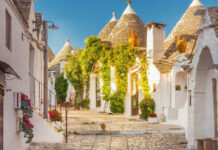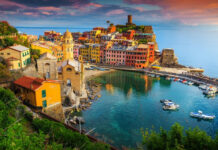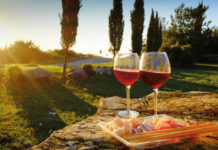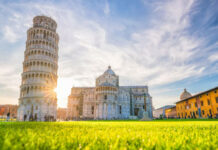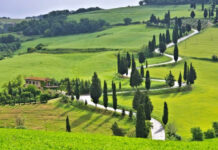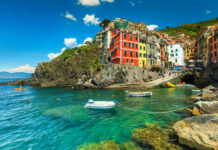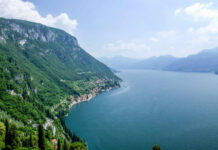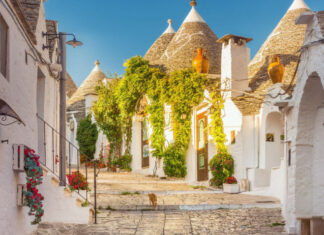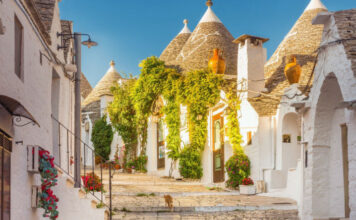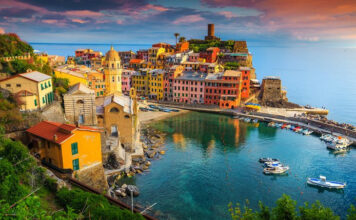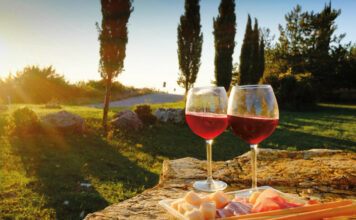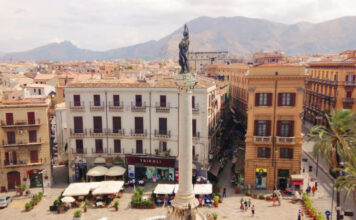Italy is one of the most diverse, and one of the great wine regions of the world.
There are more than 300 grape varieties with plantings in one of more than 20 wine regions, decorating the slopes and valleys of this boot-shaped country for an incredible range of flavors, styles and terroir.
We will take a look at the main wine regions of Italy, highlighting what’s great about each of them, in this guide.
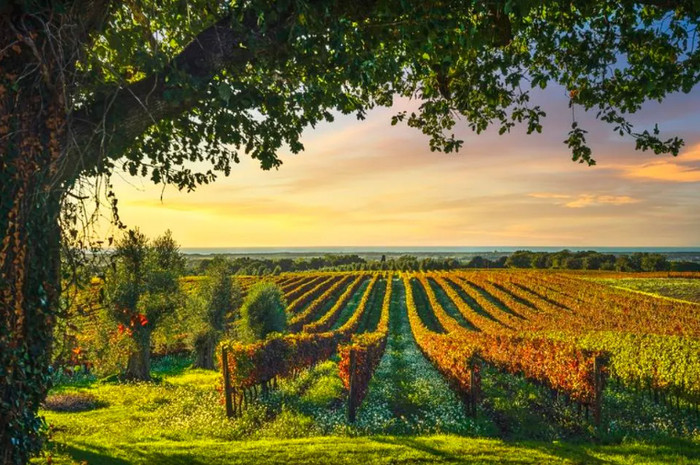
Tuscany
Perhaps the most well-known of Italy’s wine regions,
Tuscany is characterized by its gentle rolling hills, cypress trees and historic hilltop villages. The winemaking dates back to the Etruscans in the 8th century BCE. Tuscany today accounts for 8% of all Italian wine.
Popular Tuscan wines include:
- Chianti: The easy-drinking table wines of Chianti and premium Classico labels fall at opposite ends of the spectrum, but can both benefit from its flavor profile of tart cherry and herbs, making it a versatile food pairing.
- Brunello di Montalcino: Brunello is Tuscany’s most celebrated wine and is made exclusively from Sangiovese grapes. Complex and ageworthy, with flavors of cherry, leather and tea leaves.
- Vino Nobile di Montepulciano: A noble Sangiovese-based wine with delicate fruit, dried cherry and supple tannins.
- Super Tuscans: Unconventional blends, often with French varieties like Merlot and Cabernet. Concentrated and powerful.
Beyond its Sangiovese-based reds, Tuscany makes thrilling whites like Vernaccia di San Gimignano and Vermentino.
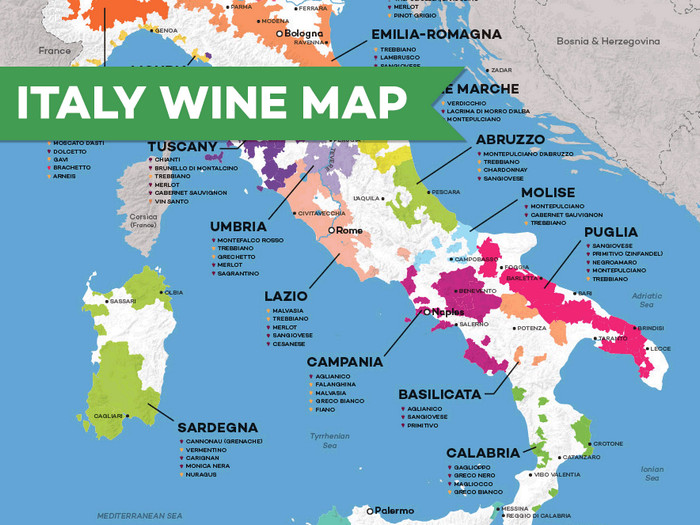
Terroir
Tuscany has some diversity of microclimates and soils that give complexity to its wines. Key factors include:
- Hillsides and mountains: Vineyards at higher elevations enjoy cooler temperatures, sunshine, ventilation and stony, well-draining soils.
- Access to the Mediterranean: The moderating influence of the sea keeps temperatures relatively warm in winter and summer.
- Mixed soils: Everything from limestone to shale, to clay, to sandstone. Sangiovese is best in dry, calcareous soils.
- Rainfall: With the exception of some arid regions requiring irrigation, most vineyards receive ample rainfall.
Major Subregions
The most well known subregions of Tuscany include:

- Chianti: A zone of Italy’s largest classified wine area lying between Florence and Siena. Renowned for inexpensive Chianti and expensive Chianti Classico labels.
- Montalcino: Brunello di Montalcino is made only from grapes grown on the hills surrounding Montalcino. It’s warmer and drier than Chianti.
- Montepulciano: Source of the famous Vino Nobile di Montepulciano, made with Sangiovese and other local grapes.
- Bolgheri: Seaside region that produces lush Super Tuscan wines of French grape origins.
Piedmont
Nestled in the northwest corner of Italy, Piedmont is celebrated for its graceful, perfumed reds and sparkling whites. The continental climate, rugged geography and diverse soils encourage a variety of styles of wine.
Iconic Piedmont wines are made from:
- Barolo: Called the “King” of Italian wines, Barolo is a DOCG produced solely of Nebbiolo in the Langhe hills south of Alba. Big but subtle, with notes of tar, roses, cherries and truffles.
- Barbaresco: A friendlier, gentler DOCG wine than Barolo, also from Nebbiolo. Exhibits aromas of violets, spices and licorice.
- Barbera: One of Piedmont’s most planted grapes, producing medium-bodied wines brimming with bright cherry fruit and zippy acidity.
- Gavi: DOCG white wine produced from the Cortese grape, known for its crisp minerality with touches of citrus and almond.
- Moscato d’Asti: An aromatic Moscato Bianco-based white, sparkling, slumbering, cool. Like a peach, apricot, and honey.
Terroir
Distinctive elements that help define Piedmont’s terroir are:
- Foothills of the Alps: Vineyards grow on slopes at 2,300 feet. Grapes cool off in the mountain air at night.
- Continental climate: Temperatures that swing hot in the summer and cold in the winter, creating complexity in the grapes.
- Soils Limestone, clay, marl, sandstone. Some of the finest Nebbiolo vines are in calcareous marl soil.
- Fog and mist: Aid in alleviating droughts during hot summers.
Major Subregions
Piedmont Wine Regions of Note:
- Langhe: Surrounding the town of Alba, the Langhe zone is home to excellent Nebbiolo-based wines such as Barolo and Barbaresco.
- MonferratoBarbera and sparkling Asti Spumante thrive in the rolling hills of Monferrato.
- Gavi: the cortese grape reaches its zenith in the limestone soils near the town of Gavi.
- Canavese: Far northwest area in the mountains; balanced Nebbiolo and singular white Erbaluce.
Veneto
There too whites represent about two-thirds of production in Veneto. Major grape varieties are:
- Glera: The cornerstone of light, bright Prosecco sparkling wine.
- Garganega: Compounds Soave, a popular Italian white with lemon-almond flavors.
- Corvina: The main red grape in amarone and Valpolicella blends. Offers notes of cherry, prune and leather.
There are also other grapes, including Trebbiano, Pinot Grigio, Cabernet Sauvignon and Merlot.
Terroir
Central features of Veneto terroir include:
- Foothills of the Alps: Higher-elevation vineyards in cooler climates.
- Adriatic coastline: Marine influence less moderating, particularly in Soave and Prosecco areas.
- Alluvial soils: Sandy, nutrient-dense riverbed soils favor Garganega and Corvina grapes.
- Undulating landscape: The vineyards of Valpolicella are located on the rolling slopes and hillsides surrounding Verona.
Major Subregions
The diversity of Veneto is mirrored in its spectrum of wine zones:
- Prosecco: HQ for the ubiquitous sparkling wine in the countryside north of Treviso.
- Soave: The Classico zone is situated in the hills near Verona and is known for making structured, complex Garganega wines.
- Amarone: Powerful, concentrated red, produced in Valpolicella, near Verona, from partially dried grapes.
- Bardolino: Light-bodied, easy-drinking red wine from the shores of Lake Garda, dominated by Corvina grape.
Sicily
Sicily emphasizes indigenous grapes such as Nero d’Avola, Frappato, Grillo and Catarratto. Main wine styles include:
- Nero d’Avola: Sicily’s signature red, featuring flavors of ripe plum and black cherry, with spicy or smoky notes occasionally.
- Cerasuolo di Vittoria: Sicily’s sole DOCG wine, produced from a combination of Nero d’Avola and Frappato. Plump but bracing, with cherry and floral aromas.
- Marsala: This fortified wine, which typically ranges from sweet to dry, has nutty, raisin-like flavors. Grapes of Marsala are Catarratto, Inzolia, Grillo.
- Etna Rosso: Svelte reds produced from a blend of Nerello Mascalese and Nerello Cappuccio grapes grown in the volcanic slopes of Mount Etna.
- Malvasia delle Lipari: Made from the Malvasia grape on the Aeolian Islands, known for their floral, apricot and almond notes.
Terroir
Factors affecting the terroir in Sicily include:
- Volcanic soils: Lush, mineral-laden soils exist in the vicinity of Mount Etna and the Aeolian Islands. They lend complexity to the wines.
- Climate: dry and hot: summers in Sicily are hot and dry, with limited rain, especially inland from the coasts. Vines do poorly in the heat and soils hold little water.
- Coastal influences: Vineyards closer to the coasts experience the moderating effects of the sea. Breezes fight heat and humidity.
- Elevation: Higher-elevation vineyards in the mountainous interior have large diurnal temperature variation. Cooler nights retain acidity.
Major Subregions
Here are some important wine areas of Sicily:
- Etna: The slopes of the active volcano yield unique, mineral-driven red and white wines.
- Vittoria: Where Cerasuolo di Vittoria — Sicily’s only DOCG — reigns. Also produces Frappato and Nero d’Avola reds.
- Marsala: The hot area around the town of Marsala is where Grillo, Inzolia and Catarratto grapes flourish.
- Lipari Islands: The Aeolian Islands’ volcanic soils are ideal for Malvasia and Corinto Nero grapes.
Final Thoughts
Each region is full of opportunities to discover lesser-known grapes, producers and village wines. For oenophiles in Italy, there’s a lifetime of thrilling discoveries.
